Some of the links in this post may be affiliate links.
Watermelon peperomia, or Peperomia argyreia, is a beautiful foliage houseplant named after the fact that its leaves resemble watermelon rinds. And what beautiful foliage it is! I’ve known many people that have killed this plant, but if you follow my tips, you can succeed so keep reading!
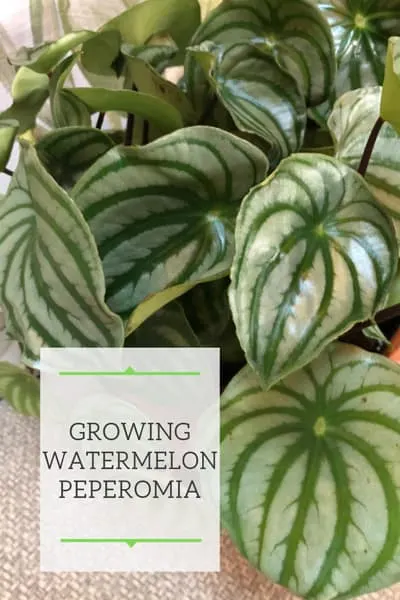
This plant is truly easy to grow if you follow my lead!
Table of Contents
WATERMELON PEPEROMIA CARE
Although this plant is mainly grown for its foliage, it is a flowering plant. No one would purchase it for its flowers, but they do bloom!
Take a look at the green flower spikes that they produce.
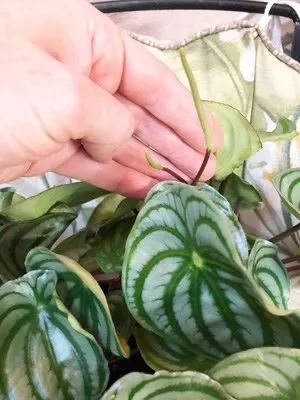
Like I said…no one grows these plants for their flowers! Let’s talk a little about how to care for Peperomia argyreia.
I’ll mention some basic care tips for this plant, and later on will talk about what I consider the absolute most important factor in keeping this plant alive (and thriving) and also how to propagate it.
LIGHT
Watermelon peperomia definitely prefers bright conditions, but mostly indirect light. These plants can not take too much direct sun otherwise their vivid foliage coloration will wash out.
These plants are well suited to larger Northern exposure windows, and Eastern exposure windows as well where they would receive some morning sun. If all you have is a window with a lot of direct sun, you may want to diffuse the light a bit.
Just keep in mind that the higher light you have these in, the more quickly they will dry out, so you’ll need to monitor that carefully. More on that in the watering section.
FERTILIZING
Watermelon peperomias are considered to be light feeders so avoid too much fertilizer otherwise your plant may lose its characteristic compactness.
I like to fertilize regularly, but very dilutely. This is the method I really use for all my houseplants.
My favorite fertilizer has become Dyna-Gro Grow. It is a complete fertilizer that contains all the necessary macro and micronutrients for plant growth and is urea-free. I’ve achieved fantastic results with this fertilizer.
Of course, I would like to mention that fertilizers are NO substitute for poor cultural conditions. You should provide fertilizer on top of proper light, watering, etc.
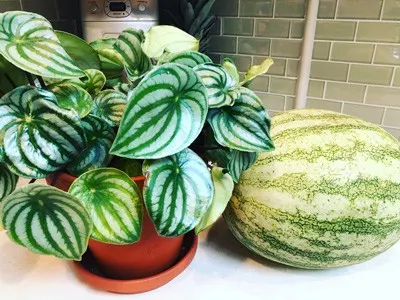
Temperature
Watermelon peperomia are definitely freeze babies and they like to stay warm. These plants come from the tropical regions in northern South America. If at all possible, keep this plant above 60F (about 16C).
As a rule of thumb, for tropical houseplants, I like to tell people that if you are comfortable, then your houseplant is OK when it comes to temperature.
Always avoid any really cold drafts.
Watering
Now we are getting to some of the most critical care tips for Watermelon Peperomia.
These plants are very sensitive to extremes in soil moisture. I’ll get to the best soil mixes to use for these plants later. For now, let’s talk a bit about watering.
Try not and let this plant completely dry out. If you do, what you’ll notice is that the lower leaves and petioles (the “stems” attached to the leaves) will droop.
Withhold water for even longer, and the entire plant will be droopy and start to collapse.
Ironically, the same thing will happen if they stay wet for too long. If these plants stay wet for too long, they are prone to rot.
So you’ll want to find a happy medium and avoid “overwatering.”
Simply wait until the surface of your soil is dry before giving it a thorough watering. Never let these plants sit in water. Always discard extra water that comes through the drainage hole of your pot.
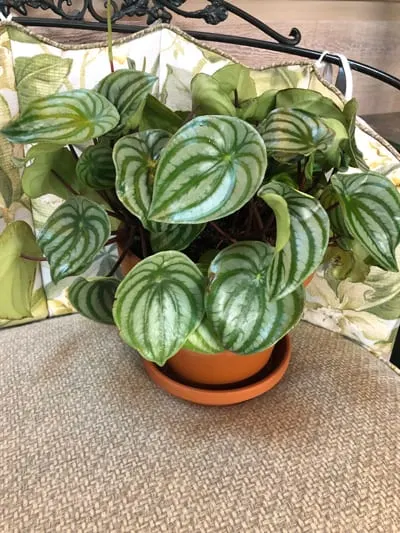
If you notice that your plant is drooping, and also the leaves are turning yellow, you should immediately feel the soil.
Your soil has gone either completely dry or your soil is wet.
I haven’t been the best all the time with watering all my plants since I have SO many and it’s hard to keep up out of busyness or laziness…and for me, this has happened many times because I’ve allowed my soil to get bone dry.
So what I do is remove any leaves that are severely yellowed or very droopy, give it a good water and try not to let it happen again.
On the other hand, if your soil feels wet…then you have to determine why. Does your pot have a drainage hole? If not, repot it into one that does.
Did you let your plant sit in water in a saucer for a long time? Always, always discard excess water. And try not to let it happen again.
Potting Mix
I’ve been a stickler for potting mixes. You should put in a little more effort into choosing a good potting mix for your plants. Having your houseplants thrive depends on many factors.
You can’t just have one thing right. You need to have multiple things right (watering, soil mix, light, etc) in order to truly have a thriving houseplant.
Potting mixes are one of the most important factors. I rarely will use a potting mix straight out of the bag anymore. Depending on what I have on hand, I will either add some perlite, orchid bark, or pumice to a prepackaged potting mix.
Why do I do this? Because drainage and oxygen to plant roots are vitally important! By introducing a larger particle size (from the perlite, bark, or pumice) to the potting mix, it will do 2 things for you.
First, it will improve the rate at which water drains. Secondly, there will be more oxygen available at the plant roots because you improved the soil structure.
So it will be less likely that you will “overwater” your plants. “Overwatering” kills your plants because waterlogged soil is depleted of oxygen.
I’ll get to propagation soon, but I grew a beautiful Watermelon Peperomia in a soil blend to which added pumice. In my most recent project, I added orchid bark to a potting soil.
I strongly advise you to consider adding either perlite (I prefer the larger size perlite), orchid bark, or pumice to your potting mixes. Regardless of what you are planting! You will not regret it.
I have all 3 items on hand at all times because I like perlite in all my mixes. I grow plenty of orchids so I always have orchid bark, and I love using pumice for my succulents, so nothing will go to waste!
So don’t underestimate the importance of a good potting mix! Going the extra effort of adding additional components to your prepackaged soil mixes will go a long way.
Watermelon Peperomia Propagation
These plants are very easy to propagate. There are two ways that you can propagate and I will show you photos of one way that I’ve done it.
You will need to choose a healthy leaf. Don’t use a leaf that has yellowed or that is heavily damaged.
Simply cut a leaf off the plant (actually, you’re going to be cutting the petiole which is the leaf “stem”). Then you can either propagate it in water or place it in soil.
I like to water propagate so I placed all my cuttings in vases:
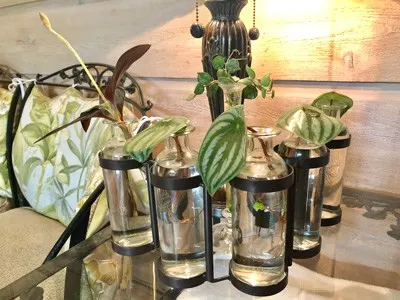
The time they take to root will vary, but mine rooted within about a couple months or so. The roots will form right where you cut the petiole, and the pups or small plants will follow shortly afterwards.
Take a look at this cutting that actually produce two sets of pups! You can see pups were produced further up on the petiole because the petiole was damaged. Talk about putting a positive spin on things…
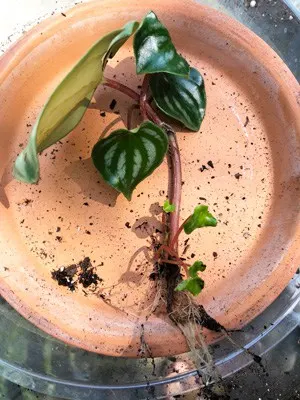
Once your cuttings have roots, or you can also wait until the pups start to grow, you can pot it up in soil.
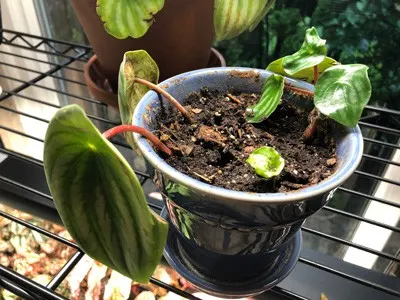
A few months later, here is the same pot (and this is also after neglected to water it a few times!)
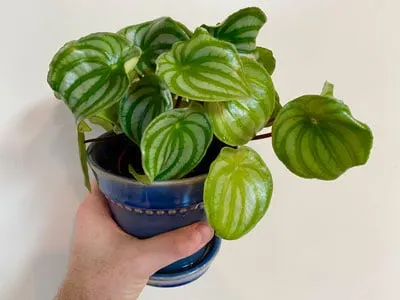
Of course if you prefer soil propagation, you could have dipped the cutting in rooting hormone and placed it right into soil instead of water.
Another method to propagate Watermelon peperomia is to take leaf cuttings. You actually would cut the leaf horizontally in half and insert the leaf segments into the soil (with the cut side inserted in the soil).
This method is supposed to produce pups more quickly, but I haven’t tried it myself.
One last tip, if you are propagating anything, always do multiple cuttings (if you can) because not every cutting will grow roots.
Lastly, check out my YouTube video where I show how I repotted and propagated my Watermelon Peperomias!
Want to grow other kinds of Peperomia? There are lots! I’ve also written about the gorgeous Peperomia Ruby Cascade and the rare Peperomia perciliata that I planted in a terrarium.
They’re an amazing genus of plants for the houseplant enthusiast!

Deidte
Saturday 20th of January 2024
Hello, thanks for your great information. I am having trouble with my watermelon peperomia with the leaves curling in tight. I have tried changing the place where is sits to see if its the light, but it is still happening. Can you please inform me as to what is causing this.
Raffaele
Thursday 25th of January 2024
How long have you had the plant? How are you approaching watering? What kind of light is your plant getting? (exposure of the window).
Lee Smith
Friday 13th of October 2023
I have a watermelon plant and it seems the base, stem, bark, is above the soil! Is this normal or do I need to add soil to cover most or all of that? It looks beautiful other than that! Help please! Lee in Pennsylvania
Raffaele
Friday 13th of October 2023
Just add a little more soil. No biggie!
Melissa
Thursday 5th of January 2023
Hi Raffael!
Thanks so much for the tips in this post! Getting ready to repot my Watermelon Peperomia. What ratio do you use for the potting soil, perlite and or pumice?
Raffaele
Thursday 5th of January 2023
Hi Melissa! Hm, I should have added that to the post, but it can vary depending on growing conditions and how well you can keep up with watering. You can try maybe 3 parts potting mix to 1 part perlite or pumice. I'm liking pumice more and more since it doesn't float to the top like perlite does, but either will do :-) Good luck!
Deborah
Wednesday 3rd of August 2022
I do not get a lot of sun light so trying to get plants that will Grow in los sunlight
Faith
Friday 7th of May 2021
Oh...and one more thing. Anytime, I try to water propagate the stems ALWAYS turn black & No luck with leaf propagation yet :(
Raffaele
Friday 7th of May 2021
Try changing the water frequently and giving your propagations enough light. Keep your cuttings by a window where you would normally keep a regular plant. If you do these two things, it's pretty easy. And always do more than one leaf if you can since not all leaves will necessarily root, and only choose very healthy leaves for the best chances of success.